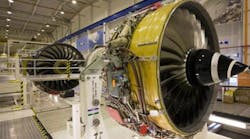PARIS -- Behind the eye-popping aircraft deals -- Boeing (IW 500/14) received over a $100 billion in orders at last week's Dubai air show -- it is in large part the engine makers who are driving the mega sales say experts.
They may not be as well-known as Boeing or Airbus, but the major engine manufacturers – U.S. companies General Electric (IW 500/6) and Pratt and Whitney, Britain's Rolls-Royce (IW 1000/234) and France's Safran (IW 1000/235) -- account for major part of the aviation market.
Engines account for about a quarter of the total cost of an aircraft, according to Richard Aboulafia at the aerospace and defence consultancy Teal Group.
The numbers are not insignificant -- GE took in $26 billion orders in one day at Dubai.
But engines have been also been a major source of innovation -- it is the gains in fuel economy that are boosting orders of new aircraft by airlines.
While carriers need to add aircraft to meet air traffic growth, which is doubling every 15 years, sustained high oil prices have pushed airlines to seek competitive advantage by acquiring new-generation models that promise savings on fuel.
At Dubai, Boeing's new long-haul 777X struck a record product launch for a commercial airliner by value, with a debut of $95 billion in orders.
Boeing says the new version of its biggest commercial success will burn 20% less fuel while carrying more passengers. Like the 787 Dreamliner, some of the gains in efficiency will be from using lightweight composite materials, but mostly they will come from the engines.
Jet Engines Drive Aircraft Designs
"When a manufacturer announces a new aircraft model, the engine makers draws upon the technologies it feels are ready to propose a motor that offer a performance gain of 10% to 20%" from existing models, said Marc Ventre, Safran's deputy chief executive for operations.
"For engine makers it’s an ongoing process, because if you don't have new technologies ready, you can't offer a new engine," he added.
Ventre said it can take 20 to 25 years to develop a new motor.
"The jet engine development program typically takes longer than an aircraft development programme," said Rick Kennedy, spokesman for GE Aviation, whose GE9X motors will power the twin-engined, twin-aisle 777X, which is to enter service around 2020.
"Now, there are clear examples where jet engines drive aircraft designs," he added.
He pointed to the 1980s, when the reliability of the new motors pushed the International Civil Aviation Organization to allow aircraft with two engines to make transoceanic trips.
"So jet engine technologies drove the move toward larger twin-engine aircraft, such as the 777, 787, and A350 aircraft," said Kennedy.
Ventre said engine manufacturers conduct their own studies of the aviation market to be able to help anticipate what aircraft makers will want.
Sometimes, they get an engine design ready before aircraft makers are ready.
"In the case of the Leap, it is clearly the engine which precedes the plane," Ventre said of the motor which Safran is manufacturing with GE Aviation in a joint venture.
"When in 2008 we announced at the Farnborough air show that we were capable of offering a new engine with new technologies that would reduce fuel use by 15-16 percent, none of the aircraft manufactures was launching a new plane," said Ventre.
But the next year China's Comac announced it would use the Leap for its entry into mid-size single-aisle segment, the C919.
Airbus followed in 2010 with the announcement of the new version of its medium-haul workhorse, the A320neo -- the moniker stands for new engine option.
The builder offers airlines the option of the Leap or Prat and Whitney's Geared Turbofan engine which will be ready in 2015, with the Leap due for delivery the following year.
Boeing followed suit some six months later, announcing in 2011 it would update the 737 into the 737MAX, whose main change is the adoption of the Leap.
- Patrick Rahir, AFP
Copyright Agence France-Presse, 2013



